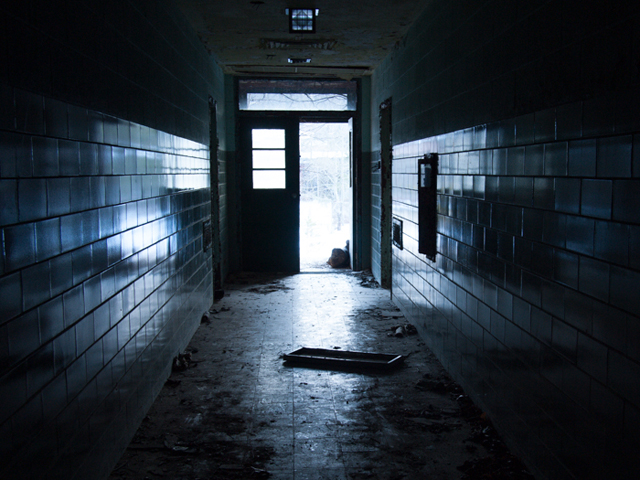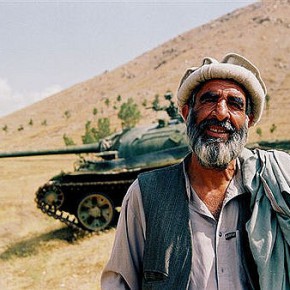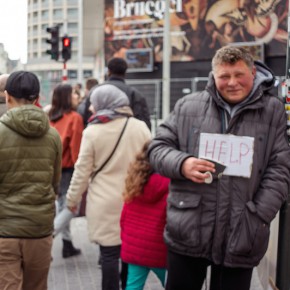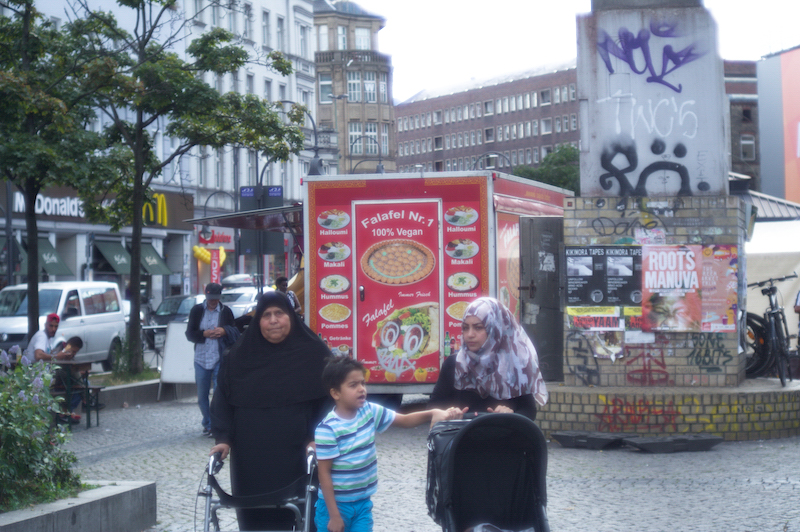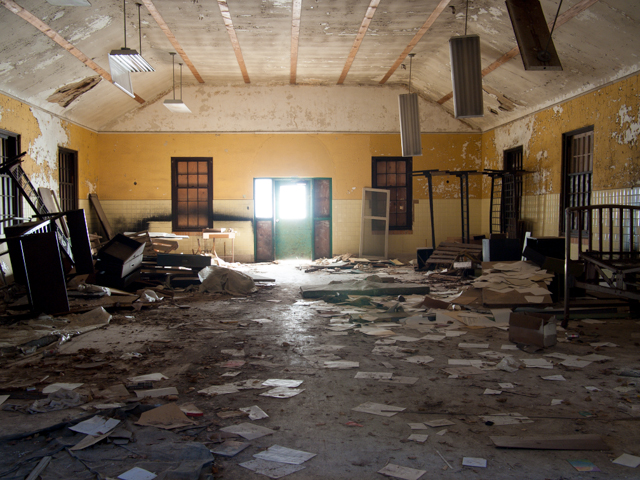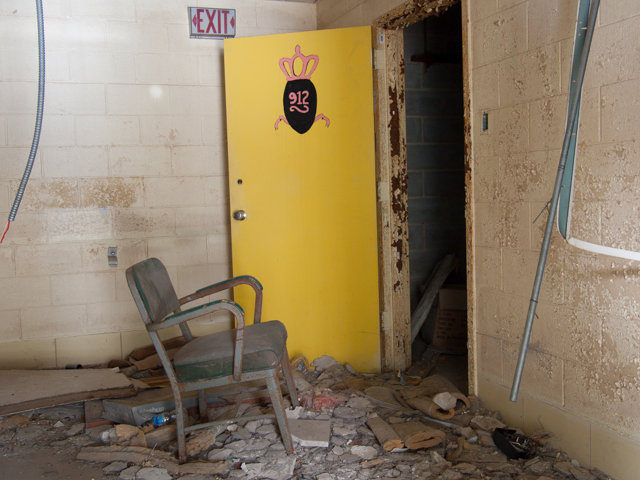It has been over a year since my friend and I visited the haunted compound of the abandoned Forest Haven mental asylum and since I began chronicling what we discovered there: a horrific testament to bureaucracy at its worst and the ragged remains of so many lives that wasted away on the outskirts of Washington D.C.
We had spent two days investigating the asylum’s labyrinthine halls, shooting photos and documenting vast amounts of what was left behind when the facility closed down. The further we dug into the complex of buildings, the more tragic and horrific tales we discovered. We witnessed lost human lives and the broken system that destroyed them. We started our expedition as an adventure, but ended up discovering a dumping ground for the unwanted.
We used our cameras to pay witness to the remnants of thousands of lives lost to a heartless bureaucratic human storage system that disposed of unwanted people for nearly a century. As our trip to D.C. came to an end, our heads were filled with voices from the corridors of Forest Haven. They called to us across the Metro and over the rooftops of government buildings. They echoed through fields of McMansions in the Maryland suburbs. They rode on the wind and insisted we listen.
We had planned on spending our last day in DC at museums to clear our heads and our psyches. Instead we answered to the voices that were calling us and headed back to that snowy trail through the woods. This time we didn’t need a map to lead us to the asylum. We followed familiar roads past towering government offices. We drove down tree-lined highways, and finally wound our way through the working-class sprawl of Laurel, Maryland.
We parked in the familiar restaurant parking lot and followed the trail of our own footsteps in the snow through the woods. I didn’t doubt our decision for a minute. I had looked through the hundreds of photos we had already accumulated. The more we dug through the appalling history of the institution, the more I was overwhelmed with how many stories remained to be told. This landscape in the heart of American democracy was littered carelessly with human lives tossed away like so much garbage. I needed to go back to Forest Haven to pay tribute and give voice to those who had never had a chance to leave its confines.
We crunched over the hill and through the woods as if we had always been there. This was familiar territory now. We passed the building that had caught our eye on that first day. The brick remains of what once was probably the home of some asylum overseer stood gutted on the hillside looking down over the sprawl of the asylum grounds. He and his family lived safely sequestered and removed from the howls and cries of the people bound to their beds at the bottom of the hill.
And there were so many of those people. People who were invisible. People who were tossed away. Whose lives were lost and stolen. People who cried and cried but whose voices were never heard or whose cries were so loud and insistent that they were silenced with drugs or gags or a combination of both. On our first two trips the evidence of these lost lives had been so overwhelming that I’d felt like I was choking on it, lost in a sea of despair. It had been like visiting the site of a mass spiritual genocide, and it was our job to document the human beings had lived and died in this place that has been erased from the map of America’s geographic and historic consciousness.
We became conduits for voices that had been walled off from society. I entered the grounds with new accumulated knowledge on that last visit. I knew of this place and the people who were abandoned there. I knew of those left choking on their own food and covered with their feces. I knew of the children who were left within its walls to deteriorate, their physical and mental capacities eroding with the deteriorated moral system that had collapsed and left them bereft. I was obsessed with documenting every piece of evidence I could find.
As we entered the grounds for our final visit to the asylum, I tried to distill the noise of the voices and find the evidence of actual lives lived. Rather than becoming overwhelmed by the sea of debris, I tried to focus on the things that spoke of actual human lives lived. We headed straight to the original cottages, expecting to find evidence of people with names and histories.
The first thing I noticed was a lone basketball hoop. Its rusted skeleton jutted toward the sky. Purposeless. A relic of recreation in a place where the majority of the residents spent their days and nights locked in rooms and to beds. Perhaps during a short period in the asylum’s history, troubled youth tossed the ball and tried to make a shot. Imagine the triumph of watching the ball go through the hoop and actually scoring. But there was no winning in this place, and the game has long been over. The basketball hoop is just a thing to collect weeds, bird shit, and memories no one wants to remember.
As I worked my way through the cottages, objects became voices of the people who were never heard. Televisions sat unplugged and lifeless in many rooms. I could almost feel faces staring into the empty screens wanting desperately to find a doorway into another world. The only thing playing was the empty reflection of buildings where people checked in and never checked out.
Perhaps the TVs played on an endless loop to drown the sound of choking and sobbing. Maybe the TVs did give the residents of Forest Haven a window to a world they would never know, a world outside the walls of the asylum. Now the TVs were gutted. Covered with graffiti. Their tubes long dead. They have been emptied of fantasies. There is no other reality but the one inside these walls where the TVs will eventually disappear just like the people who watched them.
Record players were also popular at Forest Haven. Their square bodies sit on lonely tables in the middle of dusty rooms. They lie in melted broken heaps in corners. They are heaved carelessly to floors or shoved in the back corners of closets. Their arms are broken, and their turntables have stopped turning. But somewhere in the distance someone is trying to get over the fucking rainbow while a 33 rpm spins Judy Garland. Blue birds fly while wards of the court lie on gurneys, click their heels three times, but never make it home.
In some rooms mattresses leaned against walls. Their heft hung limp like bodies barely clinging to life. Stained, sodden, and heavy with memory, the mattresses lined rooms like silent vigils. Refusing to lie down. Refusing to give up the ghost. They smelled of a thousand bodies and a million bad nights.
Suitcases were stacked on a shelf in one room. Set aside and forgotten. I imagined the young people arriving at Forest Haven with their suitcase of belongings only to have it emptied and shoved in a closet, just like the people themselves were emptied and shoved into storage rooms.
The suitcases came in all color and variety. Red vinyl. Blue plastic. Green leather. The colors of life. Representations of choice. Personality. Individual suitcases for individual people with individual stories. People whose individuality was erased with lobotomies and Thorazine. People who waited for the day when their suitcase would be returned. The day someone would come to get them, and they would leave Forest Haven. The day that never came. The suitcases remain, but the people they belonged to are buried across the grounds of the asylum.
One room must have been for infants. Child restraining seats sat akimbo on the floor. Children’s slippers and bent patent leather shoes littered the floor. At first I thought the seats were for outings, like car seats. Then I realized they were just repositories for tiny bodies. Places to keep little boys and girls buckled tight and restricted from moving.
Perhaps the toddlers watched cartoons on the TVs while they were strapped in their seats. A tiny cracked plastic Winnie The Pooh looked out the window enjoying the view of the administration building. I wonder if the children enjoyed that view. I would later learn that the morgue was in the basement of the administration building. Did the children know that they would eventually end up there? I don’t think so. I am horrified that I know, but I think it is important that you know.
In some rooms materials and objects had disintegrated into blobs. Globs of stuff that no longer had shape or identity. Shoes. Clothes. Paper. All mashed together into unidentifiable crud. Just how the people who were sentenced to Forest Haven had become. Telephone receivers uncoiled from cords in most rooms.
Phones lay on floors, dangled from walls, or sat askew on sofas. If I picked one up would I hear echoes of the last phone calls? Are you on your way? Please come get me. I’m ready to leave now. I’ve been waiting for so long. Hurry.
Tattered curtains blew through broken windows. Tattered lives lay wadded on the floor. Specificity was gone. Shoes were tossed aside with no matches to go with them. It didn’t matter because no one was leaving. Who needed a matching pair of shoes?
A blue gurney glowed in the central hall of one cottage. Outdated medical equipment surrounded it as if the doctors vanished mid procedure. Knobs with numbers measured things for which there is no measure. Pain. Loss. Abandonment.
My friend and I stayed until the rooms got impossibly dark. Corners were swallowed in darkness. Hallways disintegrated into black. Being in that asylum as night approached made me really feel the weight of darkness falling. It falls hard and thick in a place like that.
Fading light glowed through a door at the end of a hallway while night crept behind my back. I shuddered imagining being locked inside at night and being unable to step outside.
I felt there was still so much more to see, so many things to document, so many stories to be told and voices to hear, but we had to leave. Dark was coming on fast. We grabbed our cameras and tripods and rand down the hall and out the door.
I looked up to the twilight sky. Two white streaks swiped across the dark blue where airplanes left their mark as they made their way across the country. Somewhere up in the sky, passengers looked out the small ovals from their window seats and saw a cluster of old buildings on a stretch of wooded land on the outskirts of the Pentagon. They had no idea they were looking at a mass grave.
The temperature dropped fast and hard as the sun set. The chill cut into our faces as we made our way back to the dark woods. The lone wheelchair we’d seen earlier continued to sit in the snow outside the Curley building. Still waiting to be pushed out of there. Waiting to go somewhere new. We turned our backs on it and barely made it out of the woods before they were swallowed by darkness. I wonder if the wheelchair is there now or if someone is finally pushing it through the woods and to the other side of the road.
All photographs courtesy of the author. This is the fourth and final installment in a a series of photo essays about the Forest Haven asylum. You can see the first here, the second here and the third here.
